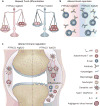PTPN22: the archetypal non-HLA autoimmunity gene
- PMID: 25003765
- PMCID: PMC4375551
- DOI: 10.1038/nrrheum.2014.109
PTPN22: the archetypal non-HLA autoimmunity gene
Abstract
PTPN22 encodes a tyrosine phosphatase that is expressed by haematopoietic cells and functions as a key regulator of immune homeostasis by inhibiting T-cell receptor signalling and by selectively promoting type I interferon responses after activation of myeloid-cell pattern-recognition receptors. A single nucleotide polymorphism of PTPN22, 1858C>T (rs2476601), disrupts an interaction motif in the protein, and is the most important non-HLA genetic risk factor for rheumatoid arthritis and the second most important for juvenile idiopathic arthritis. PTPN22 exemplifies a shared autoimmunity gene, affecting the pathogenesis of systemic lupus erythematosus, vasculitis and other autoimmune diseases. In this Review, we explore the role of PTPN22 in autoimmune connective tissue disease, with particular emphasis on candidate-gene and genome-wide association studies and clinical variability of disease. We also propose a number of PTPN22-dependent functional models of the pathogenesis of autoimmune diseases.
Conflict of interest statement
The authors declare no competing interests.
Figures



Similar articles
-
The role of PTPN22 in the pathogenesis of autoimmune diseases: A comprehensive review.Semin Arthritis Rheum. 2021 Jun;51(3):513-522. doi: 10.1016/j.semarthrit.2021.03.004. Epub 2021 Mar 4. Semin Arthritis Rheum. 2021. PMID: 33866147 Review.
-
Association between the PTPN22 gene and rheumatoid arthritis and juvenile idiopathic arthritis in a UK population: further support that PTPN22 is an autoimmunity gene.Arthritis Rheum. 2005 Jun;52(6):1694-9. doi: 10.1002/art.21049. Arthritis Rheum. 2005. PMID: 15934099
-
Regulation of autoimmune and anti-tumour T-cell responses by PTPN22.Immunology. 2018 Jul;154(3):377-382. doi: 10.1111/imm.12919. Epub 2018 Apr 16. Immunology. 2018. PMID: 29512901 Free PMC article. Review.
-
Protein tyrosine phosphatase PTPN22 in human autoimmunity.Autoimmunity. 2007 Sep;40(6):453-61. doi: 10.1080/08916930701464897. Autoimmunity. 2007. PMID: 17729039 Review.
-
The putative role of the C1858T polymorphism of protein tyrosine phosphatase PTPN22 gene in autoimmunity.Autoimmun Rev. 2013 May;12(7):717-25. doi: 10.1016/j.autrev.2012.12.003. Epub 2012 Dec 20. Autoimmun Rev. 2013. PMID: 23261816 Review.
Cited by
-
Immune-Mediated Drug-Induced Liver Injury: Immunogenetics and Experimental Models.Int J Mol Sci. 2021 Apr 27;22(9):4557. doi: 10.3390/ijms22094557. Int J Mol Sci. 2021. PMID: 33925355 Free PMC article. Review.
-
Efficient CRISPR/Cas9 Disruption of Autoimmune-Associated Genes Reveals Key Signaling Programs in Primary Human T Cells.J Immunol. 2019 Dec 15;203(12):3166-3178. doi: 10.4049/jimmunol.1900848. Epub 2019 Nov 13. J Immunol. 2019. PMID: 31722988 Free PMC article.
-
Analysis of PTPN22 -1123 G>C, +788 G>A and +1858 C>T Polymorphisms in Patients with Primary Sjögren's Syndrome.Diagnostics (Basel). 2023 Feb 27;13(5):899. doi: 10.3390/diagnostics13050899. Diagnostics (Basel). 2023. PMID: 36900045 Free PMC article.
-
Immunogenetics of juvenile idiopathic arthritis: A comprehensive review.J Autoimmun. 2015 Nov;64:113-24. doi: 10.1016/j.jaut.2015.08.002. Epub 2015 Aug 21. J Autoimmun. 2015. PMID: 26305060 Free PMC article. Review.
-
HDAC10 promotes angiogenesis in endothelial cells through the PTPN22/ERK axis.Oncotarget. 2017 May 24;8(37):61338-61349. doi: 10.18632/oncotarget.18130. eCollection 2017 Sep 22. Oncotarget. 2017. PMID: 28977867 Free PMC article.
References
-
- Bottini N, et al. A functional variant of lymphoid tyrosine phosphatase is associated with type I diabetes. Nat Genet. 2004;36:337–338. - PubMed
Publication types
MeSH terms
Substances
Grants and funding
LinkOut - more resources
Full Text Sources
Other Literature Sources
Research Materials

